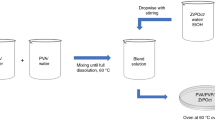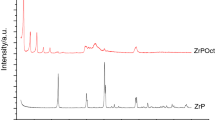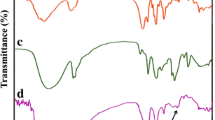Abstract
This work approaches the effects of a synthetic nanofiller on poly(vinyl alcohol)/poly(vinylpyrrolidone)/zirconium phosphate (PVA/PVP/ZrP) nanocomposites searching its future application as control drug delivery. ZrP was synthesized by reaction of phosphoric acid and zirconium (IV) oxide chloride 8-hydrate (ZrOCl2·8H2O). Nanocomposites with fixed amount of ZrP (2 mass%) and three different blend proportions were studied. Structural, miscibility, thermal, and crystallographic diffraction and dynamic-mechanical characteristics were assessed. For all nanocomposites, wide-angle X-ray diffraction showed changes for the ZrP diffraction pattern with the amount of PVA leading to an intercalated structure. Infrared spectroscopy (FTIR) revealed strong interaction between PVA and ZrP. It was observed that ZrP collaborates with the improvement in PVA thermal stability. For all nanocomposites, PVA crystallinity degree, cold crystallization, and melting temperatures were reduced. Storage modulus increased showing reinforcing action of ZrP. Miscibility study by dynamic mechanical analysis induced to infer that the PVP-rich nanocomposite formed a polymeric miscible system.






Similar content being viewed by others
References
Utracki LA. Polymer blends, vol. 11. Akron: Smithers Rapra Publishing; 2000.
Parameswaranpillai J, Siengchin S, George J, Jose S. Shape memory polymers, blends and composites. New York: Springer; 2019.
Sedaghat E, Rostami AA, Ghaemy M, Rostami A. Characterization, thermal degradation kinetics, and morphological properties of a graphene oxide/poly (vinyl alcohol)/starch nanocomposite. J Therm Anal Calorim. 2018. https://doi.org/10.1007/s10973-018-7649-1.
Gökmeşe F, Uslu İ, Aytimur A. Preparation and characterization of PVA/PVP nanofibers as promising materials for wound dressing. Polym-Plast Technol. 2013. https://doi.org/10.1080/03602559.2013.814144.
Ragab HM. Spectroscopic investigations and electrical properties of PVA/PVP blend filled with different concentrations of nickel chloride. Phys B. 2011. https://doi.org/10.1016/j.physb.2010.11.030.
Seabra AB, de Oliveira MG. Poly(vinyl alcohol) and poly(vinyl pyrrolidone) blended films for local nitric oxide release. Biomaterials. 2004. https://doi.org/10.1016/j.biomaterials.2003.10.035.
Yu H, Xu X, Chen X, Lu T, Zhang P, Jing X. Preparation and antibacterial effects of PVA-PVP hydrogels containing silver nanoparticles. J Appl Polym Sci. 2006. https://doi.org/10.1002/app.24835.
Huang K, Hsiao C, Nien Y, Lin J. Synthesis, characterization, and application of PVP/PAM copolymer. J Appl Polym Sci. 2005. https://doi.org/10.1002/app.22795.
Szczerba M, Środoń J, Skiba M, Derkowski A. One-dimensional structure of exfoliated polymer-layered silicate nanocomposites: a polyvinylpyrrolidone (PVP) case study. Appl Clay Sci. 2010. https://doi.org/10.1016/j.clay.2009.10.015.
Loría-Bastarrachea MI, Herrera-Kao W, Cauich-Rodríguez JV, Cervantes-Uc J, Vázquez-Torres H, Ávila-Ortega A. A TG/FTIR study on the thermal degradation of poly(vinyl pyrrolidone). J Therm Anal Calorim. 2010. https://doi.org/10.1007/s10973-010-1061-9.
Shirini F, Goli-Jolodar O, Akbari M, Seddighi M. Preparation, characterization, and use of poly(vinylpyrrolidonium) hydrogen phosphate ([PVP-H]H2PO4) as a new heterogeneous catalyst for efficient synthesis of 2-amino-tetrahydro-4H-pyrans. Res Chem Intermed. 2015. https://doi.org/10.1007/s11164-015-2312-y.
Wang Q, Hikima T, Tojo K. Skin penetration enhancement by the synergistic effect of supersaturated dissolution and chemical enhancers. J Chem Eng Jpn. 2003. https://doi.org/10.1252/jcej.36.92.
Nishio Y, Haratani T, Takahashi T. Miscibility and orientation behavior of poly(vinyl alcohol)/poly(vinyl pyrrolidone) blends. J Polym Sci Pol Phys. 1990. https://doi.org/10.1002/polb.1990.090280308.
Baraker BM, Lobo B. Multistage thermal decomposition in films of cadmium chloride-doped PVA–PVP polymeric blend. J Therm Anal Calorim. 2018. https://doi.org/10.1007/s10973-018-7289-5.
Eisa WH, Abdel-Moneam YK, Shabaka AA, Hosam AE. In situ approach induced growth of highly monodispersed Ag nanoparticles within free standing PVA/PVP films. Spectrochim Acta A. 2012. https://doi.org/10.1016/j.saa.2012.03.085.
Qian X, Yin J, Feng S, Liu S, Zhu Z. Preparation and characterization of polyvinylpyrrolidone films containing silver sulfide nanoparticles. J Mater Chem. 2001. https://doi.org/10.1039/B103708K.
Lee S, Oh C, Lee D. Large improvement in the mechanical properties of polyurethane nanocomposites based on a highly concentrated graphite nanoplate/polyol masterbatch. Nanomaterials. 2019. https://doi.org/10.3390/nano9030389.
Fang F, Ran S, Fang Z, Song P, Wang H. Improved flame resistance and thermo-mechanical properties of epoxy resin nanocomposites from functionalized graphene oxide via self-assembly in water. Compos B Eng. 2019. https://doi.org/10.1016/j.compositesb.2019.01.086.
Yang Y, Liu C, Wu H. Preparation and properties of poly(vinyl alcohol)/exfoliated α-zirconium phosphate nanocomposite films. Polym Test. 2009. https://doi.org/10.1016/j.polymertesting.2008.12.008.
Mendes LC, Silva DF, Araujo LJF, Lino AS. Zirconium phosphate organically intercalated/exfoliated with long chain amine). J Therm Anal Calorim. 2014. https://doi.org/10.1007/s10973-014-4056-0.
Sue HJ, Gam KT, Bestaoui N, Spurr N, Clearfield A. Epoxy nanocomposites based on the synthetic α-zirconium phosphate layer structure. Chem Mater. 2004. https://doi.org/10.1021/cm030441s.
Boo WJ, Sun L, Liu J, Clearfield A, Sue H. Effective intercalation and exfoliation of nanoplatelets in epoxy via creation of porous pathways. J Phys Chem C. 2007. https://doi.org/10.1021/jp072227n.
Garcia EE, Freitas DFS, Cestari SP, Coval DR, Mendes LC, Albitres GAV. Zirconium phosphate changing hygroscopicity of polyamide-6 in nanocomposites PA-6/ZrP. J Therm Anal Calorim. 2019. https://doi.org/10.1007/s10973-019-08396-1.
Alberti G. Syntheses, crystalline structure, and ion-exchange properties of insoluble acid salts of tetravalent metals and their salt forms. Acc Chem Res. 1978. https://doi.org/10.1021/ar50124a007.
Chowreddy RR, Nord-Varhaug K, Rapp F. Recycled polyethylene terephthalate/carbon nanotube composites with improved processability and performance. J Mater Sci. 2018. https://doi.org/10.1007/s10853-018-2014-0.
Martins-Franchetti SM, Campos A, Egerton TA, White JR. Structural and morphological changes in Poly(caprolactone)/poly(vinyl chloride) blends caused by UV irradiation. J Mater Sci. 2007. https://doi.org/10.1007/s10853-007-2210-9.
Campos A, Marconato J, Martins-Franchetti S. Biodegradation of blend films PVA/PVC, PVA/PCL in soil and soil with landfill leachate. Braz Arch Biol Techn. 2011. https://doi.org/10.1590/S1516-89132011000600024.
Lewandowska K. The miscibility of poly(vinyl alcohol)/poly(N-vinylpyrrolidone) blends investigated in dilute solutions and solids. Eur Polym J. 2005. https://doi.org/10.1016/j.eurpolymj.2004.08.016.
Santana OO, Maspoch ML, Martínez AB. Polycarbonate/acrylonitrile-butadiene-styrene blends: miscibility and interfacial adhesion. Polym Bull. 1998. https://doi.org/10.1007/s002890050424.
Al-Jabareen A, Illescas S, Maspoch ML, Santana OO. Effects of composition and transesterification catalysts on the physico-chemical and dynamic properties of PC/PET blends rich in PC. J Mater Sci. 2010. https://doi.org/10.1007/s10853-010-4753-4.
Mendes LC, Pereira PSC. Solid state polymerization: its action on thermal and rheological properties of PET/PC reactive blends. Polimeros. 2013. https://doi.org/10.4322/polimeros.2013.031.
Mendes LC, Rodrigues RC, Silva EP. Thermal, structural and morphological assessment of PVP/HA composites. J Therm Anal Calorim. 2010. https://doi.org/10.1007/s10973-010-0835-4.
Cheng Y, Chuah GK. The synthesis and applications of α-zirconium phosphate. Chin Chem Lett. 2019. https://doi.org/10.1016/j.cclet.2019.04.063.
Xiao H, Liu S. Zirconium phosphate (ZrP)-based functional materials: Synthesis, properties and applications. Mater Des. 2018. https://doi.org/10.1016/j.matdes.2018.05.041.
Dal Pont K, Gérard JF, Espuche E. Modification of α-ZrP nanofillers by amines of different chain length: consequences on the morphology and mechanical properties of styrene butadiene rubber based nanocomposites. Eur Polym J. 2012. https://doi.org/10.1016/j.eurpolymj.2011.11.006.
Gardolinski JE, Carrera LCM, Cantão MP, Wypych F. Layered polymer-kaolinite nanocomposites. J Mater Sci. 2000. https://doi.org/10.1023/A:1004820003253.
Fong H, Liu W, Wang C, Vaia RA. Generation of electrospun fibers of nylon 6 and nylon 6-montmorillonite nanocomposite. Polymer. 2002. https://doi.org/10.1016/S0032-3861(01)00665-6.
Wu T, Chen E, Liao C. Polymorphic behavior of nylon 6/saponite and nylon 6/montmorillonite nanocomposites. Polym Eng Sci. 2002. https://doi.org/10.1002/pen.11018.
Chang J, An YU, Cho D, Giannelis EP. Poly(lactic acid) nanocomposites: comparison of their properties with montmorillonite and synthetic mica (II). Polymer. 2003. https://doi.org/10.1016/S0032-3861(03)00276-3.
Abdelrazek EM, Elashmawi IS, Labeeb S. Chitosan filler effects on the experimental characterization, spectroscopic investigation and thermal studies of PVA/PVP blend films. Phys B. 2010. https://doi.org/10.1016/j.physb.2010.01.095.
Afzal HM, Shehzad F, Zubair M, Bakather OY, Al-Harthi MA. Influence of microwave irradiation on thermal properties of PVA and PVA/graphene nanocomposites. J Therm Anal Calorim. 2019. https://doi.org/10.1007/s10973-019-08419-x.
Mondal D, Mollick MM, Bhowmick B, Maity D, Bain MK, Rana D, et al. Effect of poly(vinyl pyrrolidone) on the morphology and physical properties of poly(vinyl alcohol)/sodium montmorillonite nanocomposite films. Prog Nat Sci-Mater. 2013. https://doi.org/10.1016/j.pnsc.2013.11.009.
Abou Taleb MH. Thermal and spectroscopic studies of poly(N-vinyl pyrrolidone)/poly(vinyl alcohol) blend films. J Appl Polym Sci. 2009. https://doi.org/10.1002/app.30082.
Shi Y, Xiong D, Liu Y, Wang N, Zhao X. Swelling, mechanical and friction properties of PVA/PVP hydrogels after swelling in osmotic pressure solution. Mater Sci Eng C. 2016. https://doi.org/10.1016/j.msec.2016.04.042.
Peppas NA. Infrared spectroscopy of semicrystalline poly(vinyl alcohol) networks. Macromol Chem Phys. 1977. https://doi.org/10.1002/macp.1977.021780228.
Baraker BM, Lobo B. UV irradiation induced microstructural changes in CdCl2 doped PVA–PVP blend. J Mater Sci Mater El. 2017. https://doi.org/10.1007/s10854-017-8355-7.
Betti NA. Thermogravimetric analysis on PVA/PVP blend under air atmosphere. Eng Technol J. 2016;34:2433–41.
Ravindra C, Sarswati M, Sukanya G, Shivalila P, Soumya Y, Deepak K. Tensile and thermal properties of poly(vinyl pyrrolidone)/vanillin incorporated poly (vinyl alcohol) films. Res J Phys Sci. 2015;3:1–6.
Elashmawi IS, Abdel Baieth HE. Spectroscopic studies of hydroxyapatite in PVP/PVA polymeric matrix as biomaterial. Curr Appl Phys. 2012. https://doi.org/10.1016/j.cap.2011.05.011.
Abdelrazek EM, Elashmawi IS, El-khodary A, Yassin A. Structural, optical, thermal and electrical studies on PVA/PVP blends filled with lithium bromide. Curr Appl Phys. 2010. https://doi.org/10.1016/j.cap.2009.08.005.
Razzak MT, Zainuddin Erizal, Dewi SP, Lely H, Taty E. The characterization of dressing component materials and radiation formation of PVA–PVP hydrogel. Radiat Phys Chem. 1999. https://doi.org/10.1016/S0969-806X(98)00320-X.
Patil RV, Ranganath MR, Lobo B. Microstructural studies on cobalt chloride doped PVA-PVP blend. Int J Chem Technol Res. 2014;6:1852–4.
Hemalatha K, Somashekarappa H, Somashekar R. Micro-structure, AC conductivity and spectroscopic studies of cupric sulphate doped PVA/PVP polymer composites. Adv Mater Phys Chem. 2015. https://doi.org/10.4236/ampc.2015.510041.
Roohani M, Habibi Y, Belgacem NM, Ebrahim G, Karimi AN, Dufresne A. Cellulose whiskers reinforced polyvinyl alcohol copolymers nanocomposites. Eur Polym J. 2008. https://doi.org/10.1016/j.eurpolymj.2008.05.024.
Lewandowska K. Miscibility and thermal stability of poly(vinyl alcohol)/chitosan mixtures. Thermochim Acta. 2009. https://doi.org/10.1016/j.tca.2009.04.003.
Chiellini E, Cinelli P, Solaro R, Laus M. Thermomechanical behavior of poly(vinyl alcohol) and sugar cane bagasse composites. J Appl Polym Sci. 2004. https://doi.org/10.1002/app.13649.
Betzabe Gonzalez-Campos J, Garcia-Carvajal ZY, Prokhorov E, Luna-Barcenas JG, Mendoza-Duarte ME, Lara-Romero J, del Rio RE, Sanchez IC. Revisiting the thermal relaxations of poly(vinyl alcohol). J Appl Polym Sci. 2012. https://doi.org/10.1002/app.33615.
Sakurai K, Maegawa T, Takahashi T. Glass transition temperature of chitosan and miscibility of chitosan/poly(N-vinyl pyrrolidone) blends. Polymer. 2000. https://doi.org/10.1016/S0032-3861(00)00067-7.
Feldstein MM, Roos A, Chevallier C, Creton C, Dormidontova EE. Relation of glass transition temperature to the hydrogen bonding degree and energy in poly(N-vinyl pyrrolidone) blends with hydroxyl-containing plasticizers: 3. Analysis of two glass transition temperatures featured for PVP solutions in liquid poly(ethylene glycol). Polymer. 2003. https://doi.org/10.1016/S0032-3861(03)00046-6.
Hancock BC, Shamblin SL, Zografi G. Molecular mobility of amorphous pharmaceutical solids below their glass transition temperatures. Pharm Res. 1995. https://doi.org/10.1023/A:1016292416526.
Rajeswari N, Selvasekarapandian S, Karthikeyan S, Sanjeeviraja C, Iwai Y, Kawamura J. Structural, vibrational, thermal, and electrical properties of PVA/PVP biodegradable polymer blend electrolyte with CH3–COONH4. Ionics. 2013. https://doi.org/10.1007/s11581-012-0838-1.
Ramesan MT, Athira VK, Jayakrishnan P, Gopinathan C. Preparation, characterization, electrical and antibacterial properties of sericin/poly(vinyl alcohol)/poly(vinyl pyrrolidone) composites. J Appl Polym Sci. 2016. https://doi.org/10.1002/app.43535.
Acknowledgements
The authors thank the Conselho Nacional de Desenvolvimento Científico e Tecnológico (CNPq), Coordenação de Aperfeiçoamento de Pessoal de Nı́vel Superior (CAPES), Finance Code 1 and Universidade Federal do Rio de Janeiro for financial supporting of this work.
Author information
Authors and Affiliations
Corresponding author
Additional information
Publisher's Note
Springer Nature remains neutral with regard to jurisdictional claims in published maps and institutional affiliations.
Rights and permissions
About this article
Cite this article
Freitas, D.F.S., Mattos, G.C. & Mendes, L.C. Investigation on miscibility, thermal, crystallographic diffraction and dynamic-mechanical properties of poly(vinyl alcohol)/poly(vinylpyrrolidone)/zirconium phosphate nanocomposites. J Therm Anal Calorim 145, 319–329 (2021). https://doi.org/10.1007/s10973-020-09599-7
Received:
Accepted:
Published:
Issue Date:
DOI: https://doi.org/10.1007/s10973-020-09599-7




